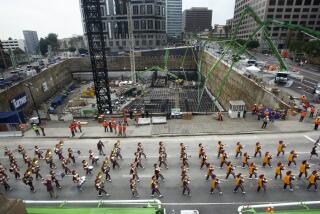South Dakota Turns Cement to Cash at State-Owned Plant
RAPID CITY, S.D. — Socialism made a big splash in South Dakota earlier this century.
The state was in the insurance business. It sold gasoline at state-owned pumps. It owned grain elevators, flour mills, a coal mine and a cement company.
The tide of governmental entrepreneurship has ebbed, however. Some of the state’s businesses were unsuccessful and closed; others were sold to private enterprise. Now, only the cement company is still in business. It is the only government-owned cement company in America.
South Dakota Cement has poured $86 million into the state treasury over the last eight years, an average of $10.75 million a year. The company has shown a profit every year since the first bag was produced in 1925, according to Gary L. Pechota, 36, president of the firm.
The company’s Dacotah brand cement is produced by blending limestone, shale, iron ore and sand, and heating it to 2,700 degrees in a 220-foot-long, 15-foot diameter kiln. During the heating a chemical reaction takes place, with the iron ore bonding the materials together.
Limestone is a key ingredient. South Dakota Cement’s plant is surrounded by a huge limestone deposit, and other raw materials come from nearby sites.
The plant can produce a million tons of cement a year.
The company markets its cement in eight states--South Dakota, North Dakota, Montana, Wyoming, Minnesota, Iowa, Nebraska and Colorado.
Helped by Location
“One of the reasons for the success of this company is our location. There is less competition here than in most other areas of the nation,” Pechota said.
The company is the only cement plant in South Dakota, and there are no other cement plants in the neighboring states of North Dakota and Minnesota. Residential and commercial construction accounts for 70% of Dacotah cement sales. Another 20% goes for paving and 10% is used by the oil industry.
The fact that South Dakota Cement is state-owned gives it another advantage: It does not pay income or corporate taxes.
With 228 employees, the cement company is one of the biggest employers in Rapid City. Although the employees work for the state, they are not civil servants. They are members of the United Steelworkers Union.
The business is administered by a seven-person commission appointed by the governor.
To date, Pechota said, the South Dakota plant has not faced significant competition from foreign imports.
Other U.S. cement manufacturers, however, have not been so fortunate. Imports have been making major inroads in the last five years.
Cement Imports Growing
“Imports are growing by leaps and bounds,” Maurice Burgener, 62, vice-president market development for the Portland Cement Assn., told The Times.
He noted that of the 83 million tons of cement sold in America last year, 14 million tons were imported from Canada, Spain, Mexico, South Korea, Australia, Venezuela, the Bahamas and seven other countries.
With cement selling at an average of $50 a ton, total sales last year were about $4.2 billion, with $3.5 billion coming from domestic production and $700 million from imports.
More to Read
Inside the business of entertainment
The Wide Shot brings you news, analysis and insights on everything from streaming wars to production — and what it all means for the future.
You may occasionally receive promotional content from the Los Angeles Times.










